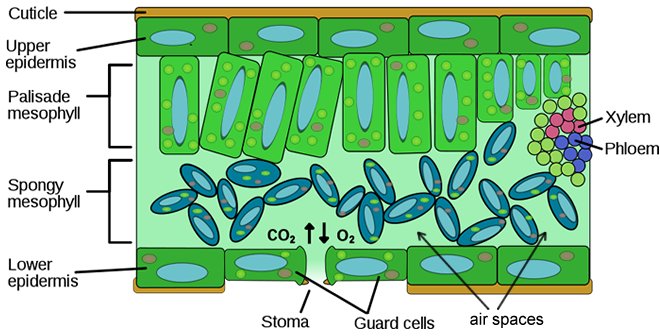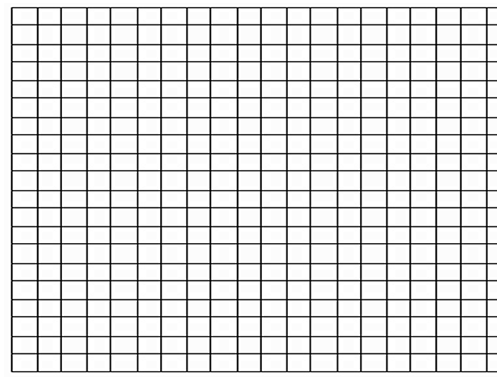Why Do the Leaves Begin to Sink Again in the Dark
Name:__________________________________________________Date:_________________
AP Biology - Investigation: Photosynthesis
Background and PreLab
Photosynthesis fuels ecosystems and replenishes the Globe'due south temper with oxygen. Like all enzyme-driven reactions, the rate of photosynthesis tin can be measured by either the disappearance of substrate, or the accumulation of products. The equation for photosynthesis is:
6CO2 + 6H2O ------low-cal--------> C6H12Ohalf dozen + 6Oii + H20
To make up one's mind the charge per unit of photosynthesis, you could measure out the product of oxygen, which is released when photosynthesis occurs or the consumption of carbon dioxide.
Leaf Structure and Function
In this investigation, you volition use a arrangement that measures the accumulation of oxygen in the leaf. Consider the anatomy of the leaf. The foliage is composed of layers of cells. The spongy mesophyll layer is normally infused with gases, oxygen and carbon dioxide. Leaves (or disks cut from leaves) volition normally bladder in h2o because of these gases. If you draw the gases out from the spaces, then the leaves will sink because they become more dense than h2o. If this foliage disk is placed in a solution with an alternate source of carbon dioxide in the form of bicarbonate ions, then photosynthesis can occur in a sunken foliage disk. Equally photosynthesis proceeds, oxygen accumulates in the air spaces of the spongy mesophyll. The leafage becomes buoyant and floats.
While this is going on, the leaf is also carrying out cellular respiration. This respiration will eat the oxygen that has accumulated and possibly cause the plant disks to sink. In other words, the buoyancy of the leaf disk is actually an indirect measurement of the Cyberspace rate of photosynthesis occurring in the leaf tissue.
Experimental Question: What factors affect the rate of photosynthesis?
Pre-lab Questions - these should be completed before the scheduled lab.
1. How can the rate of photosynthesis exist measured?
ii. Where in the prison cell of the leaf do yous find air spaces?
What is the office of the stomata?
three. What will happen if you remove the air from these spaces?
How volition air render to these spaces?
4. Instead of carbon dioxide, what will exist used to as the reactant in this lab?
5. List whatever factors that you recollect may impact the rate of photosynthesis. Consider environmental factors that you could manipulate during the lab.
Materials:
Baking soda | Liquid lather | Plastic syringes (10 mL or larger) | Leaves (spinach or ivy) | Pigsty punch or Straws | Cups or beakers | Timer | Lite source
Procedure
1. Collect leaf disks by punching holes in the night green portion of a leaf (try to get them between the veins). You lot will a total of twenty disks.
2. Brand a solution of sodium bicarbonate by mixing 300 ml of water to a pinch of blistering soda.
iii. Make a diluted solution of liquid detergent (2 drops of lather to 100 mL of water) - do non generate suds).
iv. Add ane drop of this dilute soap solution to your 300 ml bicarbonate solution –.
5. Place 10 leaf disks into the syringe and pull in a small volume of the bicarbonate and soap solution. Supersede the plunger and push out about of the air, but do not crush your leaves.
6. Create a vacuum by covering the tip of the syringe with your finger. Draw back the plunger.
seven. Release the vacuum so that the solution volition enter the disks. It may take a few times to get the disks to sink.
viii. One time they have sank, you tin can put them back into the sodium bicarbonate solution and betrayal the disks to low-cal.
9. Repeat steps 5-7 with another set of x disks. Place this set into a control chalice that contains only water and expose to light.
10. Tape the number of disks floating at the end of each minute, swirl the disks to dislodge any that may go stuck to the beaker or to each other. The experiment should continue until all the disks are floating.
xi. Repeat steps 1-10 to tape data on disks that are not exposed to light.
Data Table
| Time (min) | Light/Baking Soda | Light / No baking soda | No light/ Baking Soda | No light / Baking soda |
| 1 | ||||
| two | ||||
| three | ||||
| 4 | ||||
| 5 | ||||
| 6 | ||||
| 7 | ||||
| 8 | ||||
| 9 | ||||
| ten | ||||
| 11 | ||||
| 12 | ||||
| 13 | ||||
| 14 | ||||
| fifteen |
Analysis
Assay: To make comparisons between experiments, a standard indicate of reference is needed. Repeated testing of this procedure has shown that the point at which 50% of the disks are floating (ET50) is a reliable and repeatable bespeak of reference.
Graph your data for the experiment. X-axis is Time (min) and Y-axis is # floating disks.
Be certain to include a key for each sample prepare. There should be 4 lines on your graph. Determine the ET50 for each set of leaf disks.
Conclusion:
What is the relationship between the variables aand photosynthesis rate? This is your CLAIM.
What evidence supports those claims (summarize data)?
Provide reasoning that linke the bear witness and the claim and explains why this relationship exists. A word of photosynthesis is appropropriate in this section.
Source: https://biologycorner.com/worksheets/AP_Lab5_photosynthesis.html


0 Response to "Why Do the Leaves Begin to Sink Again in the Dark"
Post a Comment